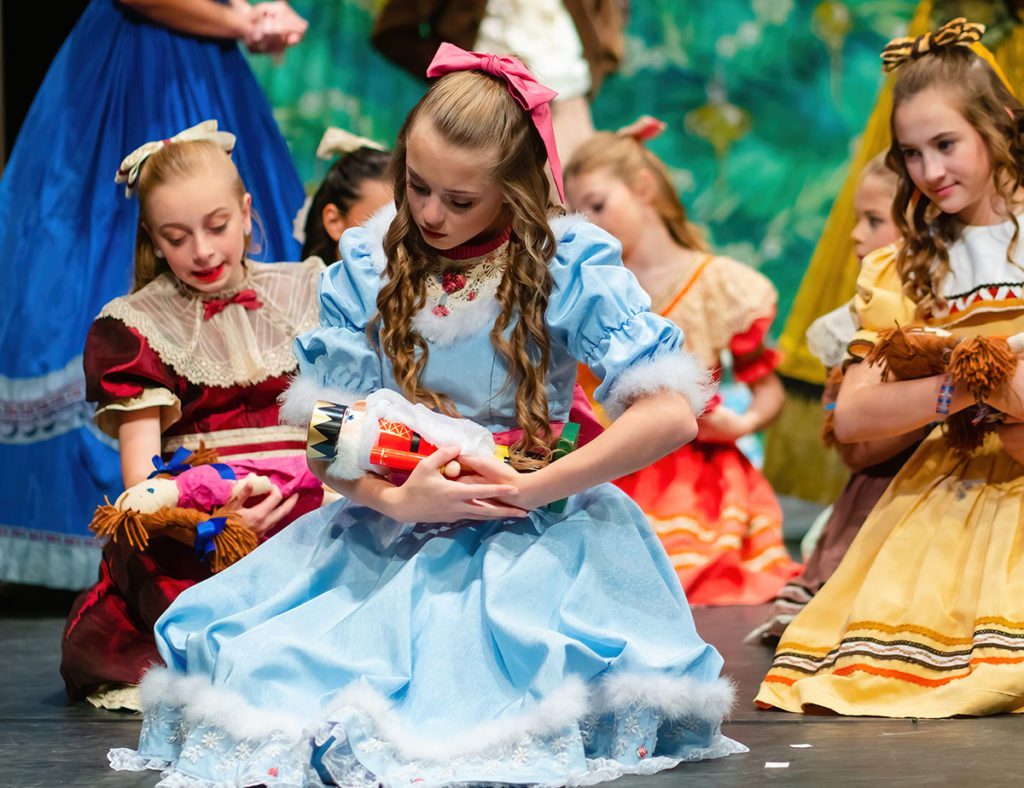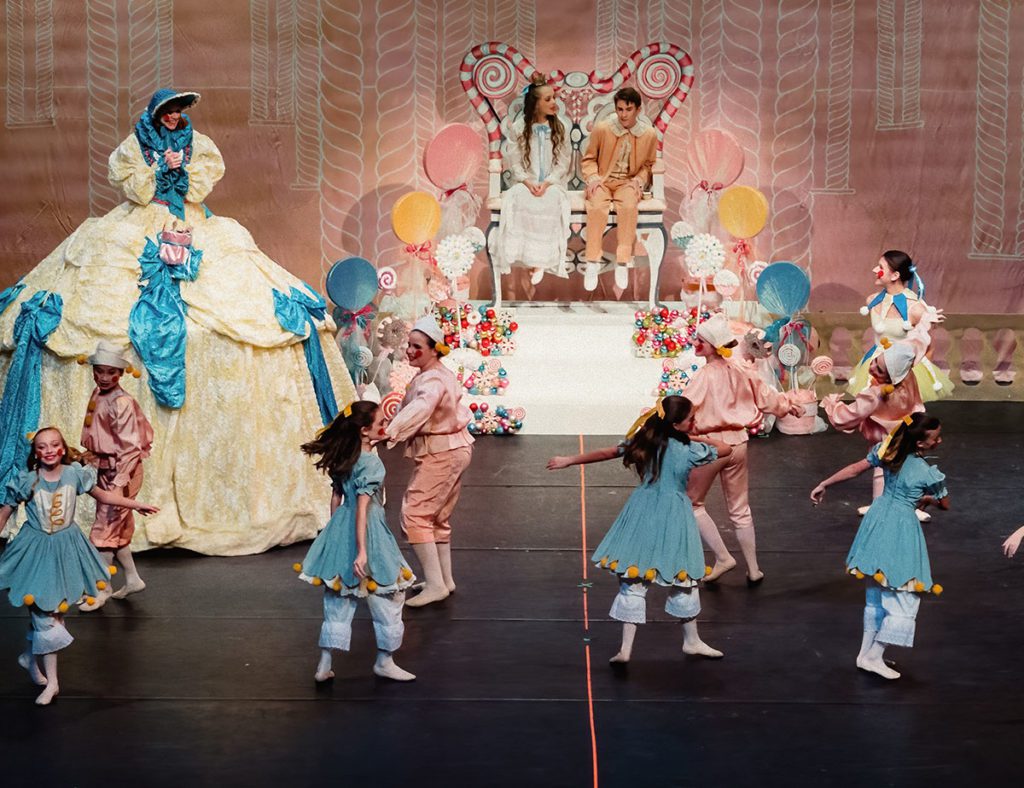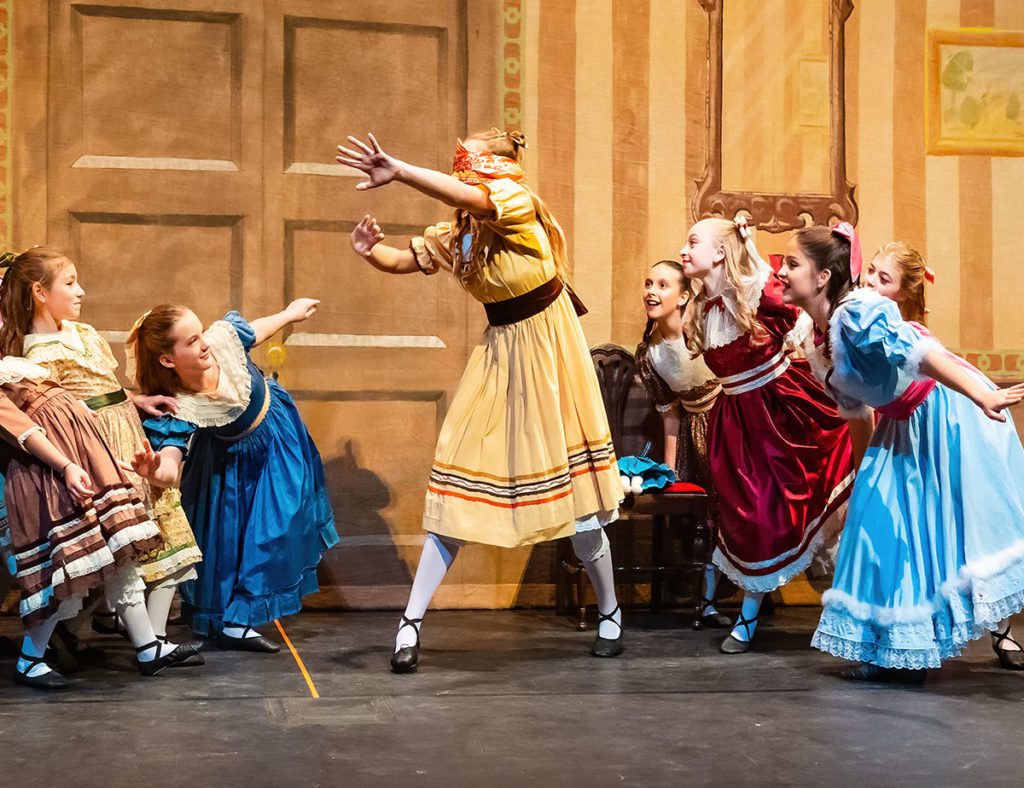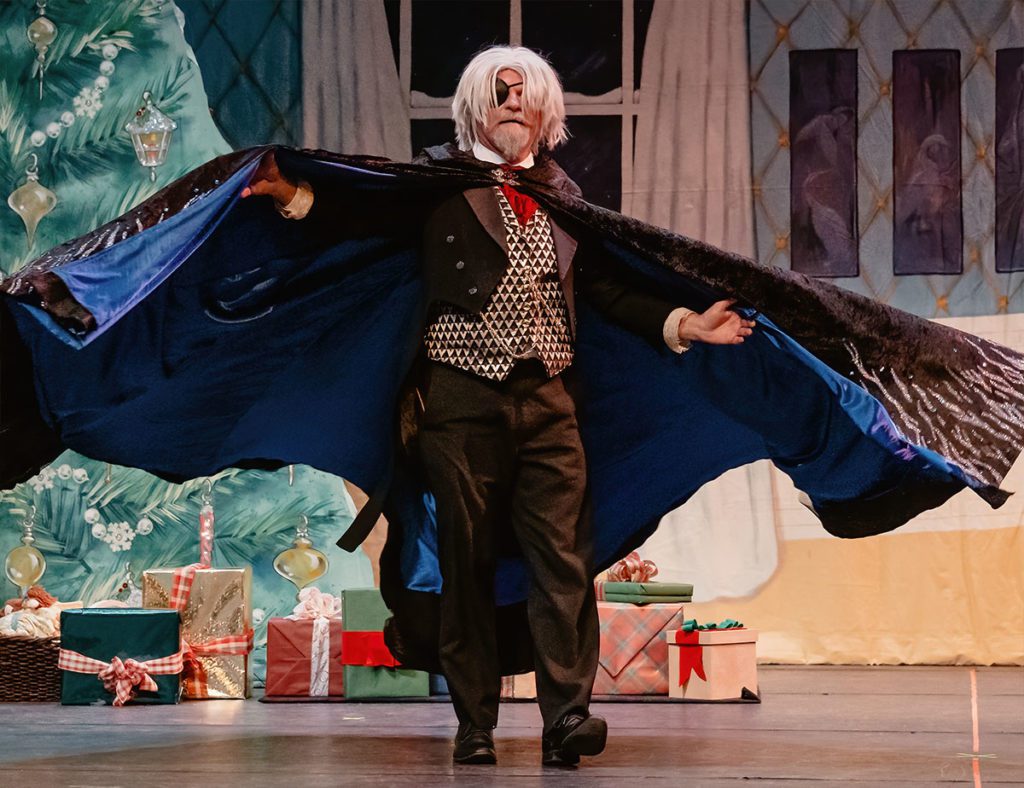Education
In 1815 German writer E.T.A. Hoffman wrote “ The Nutcraker and the Mouse King”. A young girl’s love brought life to her favorite gift, a nutcracker. The nutcracker was a Christmas gift from her strange and mysterious godfather. French writer Alexander Dumas rewrote the story in 1847. In 1891 the Imperial Theatre Directorate in St. Petersburg, Russia commissioned Peter Ilyich Tchaikovsky to write a one act opera. He chose the story of the nutcracker turned prince. The Theatre Directorate selected Dumas’ adaptation of the story, much to Tchaikovsky’s dismay. The first production of the ballet was presented in St. Petersburg in 1892. It was met with very unfavorable welcome.
The Nutcracker was quite unlike any story audiences had seen. Most ballets of the time were romantic and enchanting: Giselle, Coppelia, and Sleeping Beauty. Toys coming to life and fairy tale settings were common. However, The Nutcracker added an element of darkness – attacking mice and dueling characters.
The original choreographer for the dancers was Marius Petipa. When he became ill, his assistant Leon Ivanov took over. Although Petipa insisted he did little toward the finished production, both received public recognition and accolades.
It wasn’t until 1935 that the ballet traveled to London. The first full-length American production was in San Francisco in 1944 with William Christensen as choreographer.
Although interpretations have varied, character names changed, and plots twisted, this delightful classic stands as a seasonal gift to the child in each of us. The whimsy of Mother Ginger, the beauty of the Sugar Plum Fairy, and the command of the Nutcracker thrill us every time we experience it. Its timeless grace continues to delight audiences over one hundred years after Tchaikovsky’s first presentation.
Act I
It’s a cozy Christmas Eve at the Stahlbaum’s house. Their house is decorated with Christmas ornaments, wreaths, stockings, mistletoe and in the center of it all, a majestic Christmas tree. As the Stahlbaum’s prepare for their annual Christmas party, their children, Fritz and Clara, wait anxiously for their family and friends to arrive. When the guests finally appear, the party picks up with dancing and celebration. A mysterious guest arrives dressed in dark clothing, nearly frightening Fritz, but not Clara. Clara knows he is Godfather Drosselmeyer, the toymaker. His surprise arrival is warmly accepted and all the children dance and carry on with laughter. The celebration is interrupted again when Drosselmeyer reveals to the children that he has brought them gifts. The girls receive beautiful dolls and the boys receive bugles. Clara is given the best gift of all, the Nutcracker. Fritz grows jealous, snatches the Nutcracker from Clara and plays a game of toss with the other boys. It isn’t long until the Nutcracker breaks. Clara is upset, but Drosselmeyer fixes it with a handkerchief. Drosselmeyer’s nephew offers Clara a small make-shift bed under the Christmas tree for her injured Nutcracker.
The party grows late and the children become sleepy. Everyone generously thanks the Stahlbaum’s before they leave. As Clara’s family retires to bed, she checks on her Nutcracker one last time and ends up falling asleep under the Christmas tree.
At the stroke of midnight Clara wakes up to a frightening scene. The house, the tree and the toys seem to be getting larger. Is she shrinking? Out of nowhere large mice, lead by the Mouse King, begin to circle the room while the toys and Christmas tree come to life. Clara’s Nutcracker groups the soldier toys into battle formation and fights the mouse army. The Mouse King traps the Nutcracker in the corner, but the Nutcracker can’t overcome the Mouse King’s strength. Clara makes a desperate move to save her Nutcracker from defeat and throws her slipper at the Mouse King. She hits him directly in the head! The Nutcracker is able to overcome the stunned Mouse King and claims victory. The mice army quickly carries away their King.
Clara falls onto the Nutcracker’s bed, over-whelmed by the moment. As angels and delightful music hover over their heads, the bed turns into a magical sleigh. The Nutcracker is transformed into a human prince (who looks strikingly similar to Drosselmeyer’s nephew). He gets on Clara’s sleigh and drives through a snowy forest where the snowflakes turn into dancing maidens.
Act II
After their magical journey through the snow forest, they come to their destination in the Land of Sweets. Clara can’t believe her eyes; ladyfinger mountains topped with whipped cream whiter than snow, sweetly glazed flowers and butter-cream frosting everywhere she looks. Upon their arrival, they are greeted by the Sugar Plum Fairy. As they reenact the night’s events, the Sugar Plum Fairy becomes impressed with Clara’s bravery and the Nutcracker’s heroism. In their honor, the Sugar Plum Fairy takes them inside the Candy Castle and throws a lavish festival. They are treated like royalty and presented with every imaginable sweet. Shortly thereafter, the dancing begins.
Hot coco dances to the lively music of trumpets and castanets of the Spanish fandango. The women of coffee dance in veils and move their bodies like rising steam to an Arabian song, while Mandarin tea dances to an exotic Asian flute chorus. Bright white and red candy canes follow the Mandarin tea leaping and dancing to an invigorating Russian Trepak.
To Clara’s enjoyment there is still more to be seen. A giant gingerbread house, known as Mother Ginger, dances onto the Sugar Plum Fairy’s court. She opens her skirt and eight little gingerbread children come dancing out circling around her. After the dance is over, the children quickly file back into the large gingerbread house and Mother Ginger leaves the room. The shepherdesses are next with their dance of the flutes. Soon after, the dancing flowers enter to the tune of the harp. Perhaps the most beautiful waltz she has ever heard, Clara and the Nutcracker Prince watch with amazement. The flowers dance in beautiful mesmerizing patterns as a single Dewdrop floats above them.
Silence quickly follows the end of their dance. Clara doesn’t know what to expect next. A handsome Cavalier enters the scene and escorts the Sugar Plum Fairy to the center of the room. They dance to the most recognizable song in the entire work. The festival concludes when everyone comes together on the court and bids Clara and the Nutcracker Prince farewell. She tells the Nutcracker she wishes the adventure would never end and he tells her it won’t for those who have an eye to see it.
Clara wakes up the next morning under the Christmas tree with her Nutcracker still in her arms.
Peter llyich Tchaikovsky was born in Russia in 1840, about 600 miles east of Moscow. His father was the director for a local factory, a position of high social standing for that time. His mother and five siblings lived a modest but well furnished house. As a child Peter loved music, especially Italian and French operas.
During his young years the family moved several times. By the time he was ten years old, he was in boarding school in St. Petersburg. That year his mother took him to see Mozart’s “Don Giovanni”. At that moment, he decided to devote his life to music. Later that same year, scarlet fever broke out in St. Petersburg. Rather than remain in quarantine at the boarding school, Tchaikovsky visited a family friend. The son contracted the illness. Tchaikovsky blamed himself for the young boy’s death. Four years later, his mother died of cholera. Both of these incidents had a major impact on his life’s work.
At age 19 Peter began an office job with the Ministry of Justice in St. Petersburg. He had taken piano lessons until he graduated but his teacher did not consider Tchaikovsky gifted enough to pursue a career in music. Two years later, following a three month vacation through Europe, the young Peter quit his job and enrolled in the St. Petersburg Music Conservatory. He supported himself with temporary odd jobs. By 1865 he had seen his first full-length score performed. The following year he moved to Moscow to teach at the Moscow Conservatory.
Peter began to feel the pressure of teaching and composing. He became paranoid and overly sensitive. He managed to complete “The First Symphony” which was met with great indifference. Although they were aware of the tremendous strain on Peter, even his friends failed to encourage or support the young composer.
From 1867 to 1869 Tchaikovsky collaborated with playwright Alexander Ostrovsky on an opera based on Ostrovsky’s “The Dream
of the Voga”. After only five performances, Tchaikovsky was so embarrassed by the work that he tore the score to pieces. By the end of that year, he had scored “Romeo and Juliet” which was more favorable received. However, it wasn’t until years later that the masterpiece was recognized for its genius and beauty.
For the next ten years he wrote numerous pieces including “The Tempest” based on William Shakespeare” famous play. His music rarely followed the strict methods of Russian composition. Instead Tchaikovsky often wove strains of familiar folk songs and cultural themes into his works. He borrowed musical patterns from German and Italian composers to create a new musical sound.
This perhaps explains the curious rise and fall of Tchaikovsky’s popularity. When “Swan Lake” was premiered at the Boshoi Theater in 1877, audiences and critics were skeptical. It wasn’t until twenty years later, following Tchaikovsky’s death, that it was well received. This was followed by a string of successful major and minor works that included the opera “Eugene Onegin” and the “Maid of Orleans” based on the life of Joan of Arc.
By the time he was 37, Peter Tchaikovsky was composing full time and through the generous financial support of a wealthy widow. He married long-time admirer Antonia Milyukova.
The imperial family, in particular Czarina Maria Feodorovna and Grand Duke Konstantin, commissioned Tchaikovsky for more and more serious works. One of the most popular of this time was his “1812 Overture”, a tribute to Napoleon’s retreat from Russia(complete with real cannon blasts). By 1890 he had written three more major scores: “The Fifth Symphony”, “Sleeping Beauty” and “The Queen of Spades”. In 1891 he toured the United States returning to his beloved Russia to fullfill two more commisioned works “Iolanthe” and “the Nutcracker”.
On October 28, 1893 the premier of his “Sixth Symphony” was performed in St. Petersburg. Six days later doctors diagnosed cholera and by November 6th Peter Tchaikovsky had died. But, his music will live forever.
American ballet theatre’s ballet dictionary with video
http://www.homeschoolshare.com/nutcracker.php
http://www.nationalballet.com/images/Sample_lesson_plan.pdf
Free downloads available from Teacher Pay Teachers
http://www.teacherspayteachers.com/Product/Nutcracker-Photo-Booth-Patterns-453221
http://www.teacherspayteachers.com/Product/Vocabulary-Memory-Match-Game-Nutcracker-452188
http://www.teacherspayteachers.com/Product/Bucket-Drum-Routine-to-Trepak-from-the-Nutcracker-453809
http://www.teacherspayteachers.com/Product/Nutcracker-Mad-Lib-516889
Downloads for under $5
http://www.teacherspayteachers.com/Product/Nutcracker-Kids-Cut-Up-Sentences-172360
http://www.teacherspayteachers.com/Product/The-Nutcracker-Station-Activity-Unit-414501
Follow “Nutcracker Ideas” on Pinterest! Look for the “Teacher Ideas” board.
Language Arts: Writing
Have students write a friendly letter to one of the characters or dancers from the
Nutcracker.
Language Arts: Compare/Contrast
1.) Read a different version of the Nutcracker aloud to your students. The version of the The Nutcracker that you have read is slightly different from what students saw in the ballet. Have students chart the differences they notice on a Venn diagram or other graphic organizer. Depending on the grade level, have your students use the graphic organizer to write a paragraph or essay.
2.) Have students compare The Nutcracker with another folk tale, fairy tale, or story. Students may compare and contrast the two stories from any of a variety of angles; transformation, dream, journey, recurring characters, the problem, the resolution, etc. Use a Venn diagram or other graphic organizer to record similarities and differences. Use the graphic organizer as pre writing to then write sentences, a paragraph, or an essay.
3.) Encourage the students to rearrange the sequence of the story or to offer an alternate ending.
Language Arts: Parts of Speech Activity
Select one part of speech for students to act out every time it occurs in a read aloud of The Nutcracker.
Language Arts: Cloze Passage
Use the “fill in the blank” passage as a comprehension exercise. This can be done together as a class for younger or primary grades. A variety of additional tasks can be built into this one exercise.
Variation #1: Parts of speech – students can underline each example of a specified part of speech that occur in the passage speech
Variation #2: Synonyms and Antonyms- Students may provide either a synonym or an antonym for each example of a specific part of speech to create a more vivid description.
Variation #3: Syllables– Have students underline all words in the passage that have 2 syllables, etc.
Language Arts: Nutcracker Mad Lib
Students are given a synopsis of The Nutcracker story and then are asked to create their own version, replacing designated words with new grammatically correct words. Students can be assigned to create a specific genre, i.e. scary, silly, fantasy, or left to their own choice.
Social Studies & Language Arts
1.) For this production of The Nutcracker, the ballet was set in the 1800s. Have students write about what would happen if the story took place in a different time period. What would you change? (Costumes, sets, characters, folk dances, music, landmarks, locations, events, animals, etc.) This year’s production is the 50th anniversary of the first local performance of the ballet. Use Lake Charles in 1963 as a possible setting.
2.) Have students re-write their own version of the story using a setting in another country. Consider how costumes, sets, characters, folk dances, music, landmarks, locations, events, and animals might be different.
Social Studies: Families & Traditions
The Nutcracker story takes place at Christmas and shows how Clara’s family celebrates the holiday. What holiday traditions are special to your family? Use a Venn diagram or other graphic organizer to compare and contrast your holiday traditions with your parents or guardian. How is it different from your grandparents?
Social Studies: Climate
Does the snowflake scene in The Nutcracker remind you of winter? How would people dress in this kind of weather? What would people do in this kind of weather? Draw a picture of how you would dress in this weather, then write a few sentences about how this is different or the same from the way you dress in your climate.
Science: Habitat
Have students consider the Dance of the Snowflakes scene in The Nutcracker. Discuss what animals they might find living in this kind of habitat? What else would you likely find living in this habitat (plants, trees, insects, etc.)? Have students record their ideas on a graphic organizer and draw pictures to go along with it.



